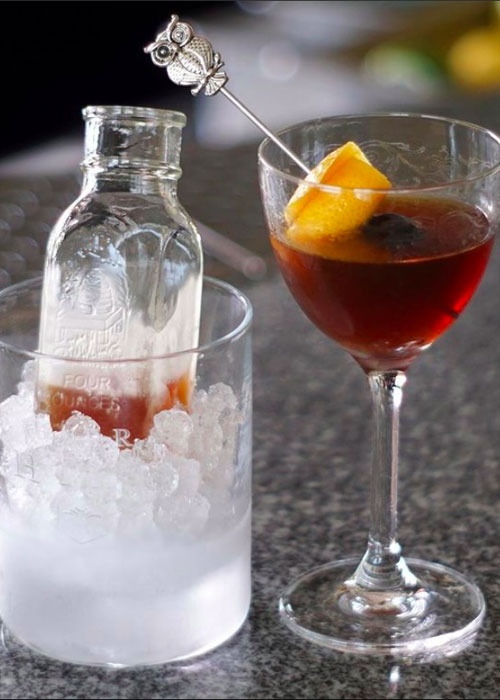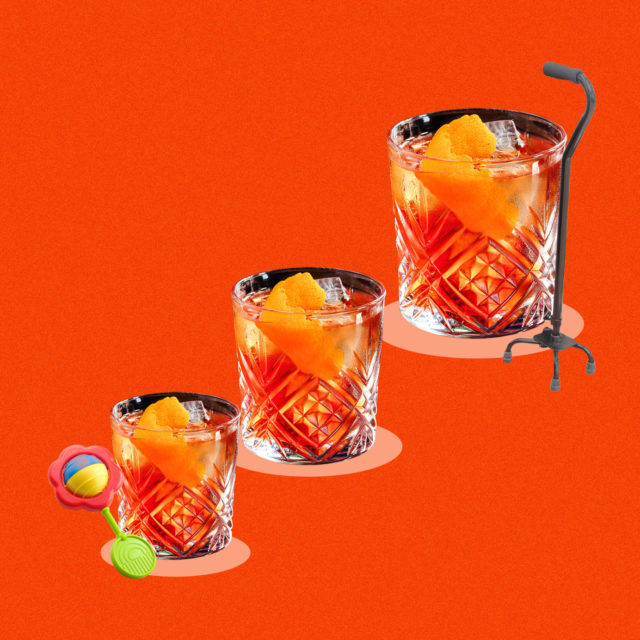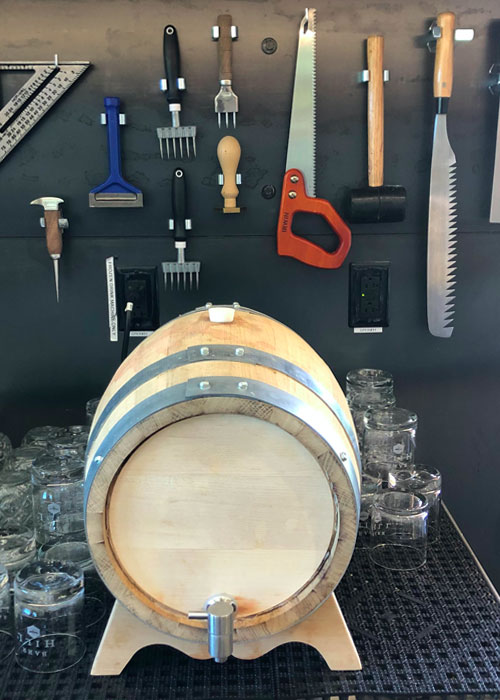Time can be many things. For Benjamin Franklin, it was money. Albert Einstein famously focused more on its relative nature. For all of us, on a daily basis, it is something that can be lost or wasted, and occasionally needs killing.
Far less appreciated is time’s potential as a cocktail ingredient. For, with a little time — and patience on the maker’s part — aged cocktails serve added levels of depth and nuance, and allow all of the components of a mixed drink to harmonize as one wonderful entity. Old becomes new.
Aging cocktails can be a simple or complicated undertaking, though the process always yields a stunningly complex conclusion. Requiring little more effort than making a standard cocktail, there are two common methods (and vessels) for aging cocktails: bottles and barrels.
While both share many of the same principles, there are marked differences and important factors to consider for each method. Time and patience always factor into the equation but the end results are worth the wait.
The Blueprint for Aging Cocktails
Just like beer and wine, not all cocktails improve with time. Those with fresh ingredients, especially citrus juice, are largely off the table, given their propensity to spoil with time — though not all bartenders agree with this assertion, especially in the case of bottle aging.
Either way, it is spirit-forward, stirred drinks that are most commonly aged, and typically those that also include fortified, aromatized wines, such as vermouth. Think: Negronis, Boulevardiers, Manhattans, even Martinis.
The high ABV content of the spirit component provides stability over time, while the bitter character from vermouth serves structure — akin to the tannins of an age-worthy red wine. As with a brash young Barolo or Bordeaux aging in oak or bottle, this bitterness slowly softens over time, transforming from edgy and slightly awkward to velvety and plush.
“You age a cocktail because you want it to change over time,” says Craig Schoettler, executive director of beverage and corporate mixologist at MGM Resorts International. “Those are the styles of drinks that will hold up over prolonged periods.”
While any volume of cocktail can be aged, recipes must be scaled up to fill the vessel in which they will reside. This prevents the drink from over-oxidizing. The process largely resembles that of batching cocktails, though, in the case of aging, dilution with water should be avoided. “The more water you add up front, the less impactful any change will be in the cocktail,” Schoettler says.
When scaling recipes that contain bitters, such as Angostura or Peychauds, Schoettler advises exercising caution. Season to taste and add less bitters than the drink will ultimately need, because as the cocktail ages, the impact of bitters grows exponentially, Schoettler explains.
By holding back, you also allow for a dash to be added when the drink is stirred with ice before serving. This livens the cocktail and gives it a “pop,” he says.

How to Make Bottle-Aged Cocktails
While barrel-aged cocktails feature more prominently on cocktail lists, that doesn’t always mean drinks aged in bottles won’t develop over time — and it certainly doesn’t mean they shouldn’t be explored.
“Bottle-aged cocktails are beautiful,” says Brendan Bartley, head bartender and beverage director at New York’s Bathtub Gin Speakeasy Bar.
The process is as simple as filling a clean glass bottle and letting it rest for a few months, he says, but the devil’s in the detail if you want to master the technique.
Just as with aging a fine wine, storage conditions are essential. Sunlight and temperature fluctuations should be avoided at all costs, so a dark, room-temperature cupboard or a red wine fridge are the ideal locations for aging. “It’s about keeping things consistent and controlled,” Bartley says.
After that, it’s just a matter of time. Within three months, the cocktail will show definite signs of aging. Any bitter or acidic notes will have settled, Bartley explains, and the drink’s sugar content will rise to the surface, “rounding off any edges.”
There are no hard or fast rules on how long to bottle-age a cocktail. Its character will continue to develop and change over time but there will ultimately come a point when the drink passes its peak and becomes too tired.
“It really depends on what you’re putting in and what you’re hoping to get out,” Bartley says. “Preference is the rule of thumb.”
How to Make Barrel-Aged Cocktails
The first and perhaps most important step in barrel aging is procuring a suitable vessel. “Not all barrels are created equal,” says Sam Nelis, head bartender and beverage director at Vermont’s Landcrafted Bar at the Barr Hill Distillery.
Rather than clicking “Buy It Now” on the first barrel you come across on Google, be sure to do some extra digging, he says. Make sure it’s made of oak, ideally American; find out if the inner staves are charred or toasted; and consider its size. All of these factors will impact the final drink.
For, in the case of barrel aging, oak is not just a vessel, but an ingredient. “You’re adding the flavors of the wood to the cocktail,” he says. Rested in charred American oak, the cocktail will benefit from added vanilla, coconut, and toasty wood. As for size, the larger the barrel, the longer the aging process will take — not to mention the more money it’s going to cost to fill with liquor.
New barrels will be dry and therefore not completely watertight when they arrive. Fill with room-temperature water and leave to sit for at least a day before emptying and approaching with your cocktail ingredients.
While it’s true that spirit-forward drinks are best suited for aging, some argue against cocktails that are dominated by whiskey or any other aged spirit. “Those notes are already there,” says Bartley. “Someone’s already professionally barreled that ingredient for you.”
Others sing the praises of barrel-aged Manhattans and Boulevardiers, though all agree the Old Fashioned is a waste of time. Perhaps best of all is the Negroni, with its boozy kick of gin and agrodolce blend of Campari and sweet vermouth. Nelis recommends straying from the traditional equal parts formula and ups the quantity of gin in his barrel-aged Negroni. This helps stabilize the cocktail over time, he says, and fights the perceived sweetness provided by the dual influence of time and oak.
Over time, that influence of oak and the overall balance of the cocktail will shift. Just like bottle aging, there is no magic number for when the cocktail will be ready, though the impact of oak arrives much faster than the gentle oxidation of bottle aging.
Regular sampling will help determine when the cocktail has hit the perfect peak for your palate. Once it has, Nelis recommends transferring the contents of the barrel to clean, sealable glass bottles. Storing in the refrigerator will significantly halt any further aging if not stop it entirely.
Don’t feel compelled to remove all of its contents, though. Instead, seek inspiration from the great fortified wines of Spain’s Jerez Triangle and start a cocktail solera. Nelis employs this method at his bar, and changes the recipe of his Negroni with each fill to further stir things up. Some batches replace vermouth with Cynar, while others pivot drastically to the White Negroni. All along, some portion of the original cocktail remains.
Should you wish to barrel-age a different cocktail, resist any temptation to rinse the barrel. Schoettler recommends instead switching to drinks with similar flavor profiles and says there’s nothing to stop a Negroni barrel from eventually being used to age a Martini, even though there are marked differences in their profiles. It just takes a few steps.
“Going from a Negroni to Manhattan is perfectly fine because you’re essentially making a hybrid Boulevardier,” Schoettler says. “And then going from a Manhattan to a Martini would make sense because it’s a less robust and pungent-flavored drink.”
Whether you’re taking Nelis’s solera route, or creating Negroni-barrel-aged Manhattans, the contents of the barrel will only continue to gain complexity with each fill. Every new batch, and even each cocktail drawn from the barrel, becomes its own, truly unique drinking experience. The possibilities are endless.

